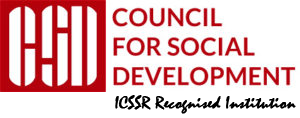Monday, 31st July, 2023, 3:00 PM to 6:00 PM
DDML Hall, Council for Social Development
Sangha Rachna 53, Lodhi Estate, New Delhi – 110003
Chair: Prof. Muchkund Dubey, President, CSD
Author: Prof. Saurabh Kumar, Visiting Professor, CSD
The accomplishments of the post-independence Indian State can be assessed as good but not good enough; impressive w.r.t. the state of stasis the nation was in under colonial rule yet underwhelming w.r.t. its founding vision and charter — of Sarvodaya through Antyodaya, if they could be so described in capsule form, and of the raison d’etre of the newly founded State being, in the lyrical words of its first Prime Minister, to (be able to) better “wipe (away) every tear from every eye”. India does not come out on top in comparison to the perform-ance of many other developing countries either, China – its only peer in the comity of nations – above all.
That mixed record is the trigger for this Essay, a strategic take on the future prospects of the Indian Republic. So also the new demands on the State machinery stemming from the multi-faceted challenges of climate and AI driven disruptive technological change, and from the state of flux the geo-political and geo-economic environment in India’s neighborhood, ‘near abroad’ and globally is in, which add to the gravity and complexity of the situation. (The challenge of the Chinese Party State galloping ahead, in the undeclared contest between the two nations for ‘Comprehensive National Power’, with its own (a)ideological, ‘results-oriented’ model of ‘neo-liberal’ “socialism with Chinese characteristics”, oxymoronic or whatever, most of all.)
The Paper posits that structural reform, going beyond mere governance reform and policy innovation, will be called for if the delivery capacity of the State machinery (its “structuration and apparatuses”, in the words foregrounded by the noted scholar, Prof. Upendra Baxi) is to be augmented; not just to be brought on par with other high performing nations but, more importantly, to be able to effectively stem the ever-deepening ‘India-Bharat’ dualism by developing capabilities for servicing the basic (human) needs of ‘Bharat’ efficaciously.
It takes the form of a ‘Concept Note’ of a proposal for a study/research-cum-dialogic project for a critical review of the experience of 75 years of the Republic aimed at identifying structural factors that impede optimal performance and remedies for overcoming them. A ‘strategic management’ approach is advocated in respect of the latter (perking up State institutions to make them more functional), viz. not taking existing structures as immutable, while devising ways and means of streamlining and fine-tuning prevailing procedures and arrange-ments for enhanced effectiveness, not excluding a remodeling of the institutional architecture if necessary.
The discussion meeting is envisaged, inter alia, as a brainstorming session for getting the Study part of the project (Section V pgs. 27-33) off the ground, as in the concluding section (Section VIII, Pg. 43).
Looking ahead, the project is expected to throw up a crisp agenda for structural reform of the Indian Republic, thought through thoroughly, pragmatically from the feasibility angle in the course of a ‘Strategic Dialogue’ between key constituencies of the national polity. One that would, hopefully, be ripe for being tossed into the political arena as a contribution to State-building by the intelligentsia, as a strand of statecraft — ever a work-in-progress in any nation-in-the-making — for the political class to mull over.
